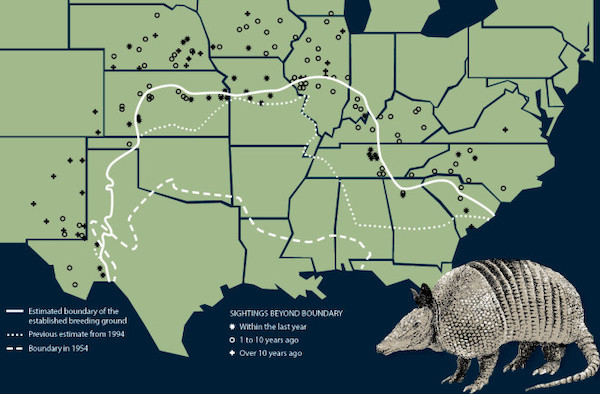Armadillos are one of nature’s stranger creatures. The prehistoric-looking mammals appear more closely related to turtles and crocodiles with leathery skin and soft-shelled “armor.” Native to South and Central America, scientists say the armadillo has been moving northward since it arrived in Texas in the 1880s and Florida in the 1920s. They are now well-established in unexpected areas like southern Illinois, Kansas, Missouri, and even Virginia. Researchers also don’t believe the odd creatures have finished their northward migration thanks to a combination of climate change and the armadillo’s underestimated adaptability. Unfortunately for farmers, expanding armadillo habitats can mean another crop nuisance to add to the list.
The species of armadillo spreading in the U.S. is known as the nine-banded armadillo, named for the nine moveable rings of armor between its shoulder and its hip shields. Rings of armor also protect its long tail. Armadillos are diggers, rooting in the ground for insects, grubs, and other tasty invertebrates which they catch with their sticky tongues. They are also burrowers, typically digging out dens a foot wide and as much as 15 feet long. They have poor eyesight so rely on their sense of smell to find food.
According to the University of Missouri, armadillos can become oblivious to anything else around them when they are hunting for food. That means humans and other threats can often get quite close to an armadillo before it gets alarmed. When they are finally startled, they tend to jump straight up in the air, another bizarre quirk of the animals. MU says armadillos are unusually noisy, too – deer hunters in the Ozarks are often surprised that the trophy buck they heard was actually an armadillo searching for food. It may surprise some to learn that armadillos can actually run pretty quickly. They are also good swimmers and can hold their breath for up to six minutes, which allows them to cross large streams or even rivers by literally walking across the bottom of them. They can also inflate their intestines and simply float across!
Scientists say part of the northward migration of armadillos has simply been opportunistic. Much like coyotes, when they lose their habitat in one area, they expand into other areas that can support them. However, biologists are shocked to find them in places that were always believed to get too cold in the winter for armadillos to survive. While it’s true that winters have gotten much milder in the U.S., some think biologists have simply underestimated how adaptable the creatures are.
Armadillos have always been classified as nocturnal animals but research suggests that is not necessarily the case. Researchers in Arkansas found that armadillo sleeping habits may have more to do with the amount of human activity in an area. Armadillos were more active at night in areas where more humans were around, while those further from the city were actually more active during the day. This adaptability might also help the armadillos’ expansion into cooler parts of the country. Daytime temperatures are typically warmer, so being out and about during the day could also allow the armadillos in regions where nighttime temperatures might dip to levels that have negative health impacts. In warmer areas, armadillos may tend to be most active at night because they also have a low heat tolerance of around just 85 degrees.
Biologists always thought that the denser soils outside the southwest were ill-suited for armadillos. Some say that assumption may have been based on the fact that the soils in areas where they have always typically been found tend to be sandier. But not even the heavy, thick soil clays found in the Midwest have deterred the creatures. In fact, the regions with these heavier soils often have a wider food supply available for armadillos. They also don’t seem to mind higher levels of rainfall or even humidity, other environmental factors that biologists previously thought would keep them relegated to the southern U.S.
The main harm inflicted by armadillos is a result of their incessant digging, which has been known to uproot crops, lawns, golf courses, flower gardens, and even damage building foundations, driveways, and other structures. Usually the digging amounts to nothing more than a nuisance but that is obviously subjective to the person dealing with the damage.
The main method for dealing with the pests is via live traps. They are agile climbers so any fence barriers are going to be more effective if they are slanted outward. MU says spotlighting and shooting armadillos at night is an effective and selective method of control. However, this method requires constant vigilance to find the animals. In addition, local regulations on discharging firearms may prohibit this control method.
Scientists say the creatures will eventually hit a wall with their northward advance due to the much harsher winter conditions that armadillos physically can’t withstand, no matter how adaptable. That line could keep shifting though, as climate change progresses. So keep armadillos in mind if you start finding disrupted ground that you’ve never experienced before. (Sources: University of Missouri Extension, National Geographic, Scientific American)








